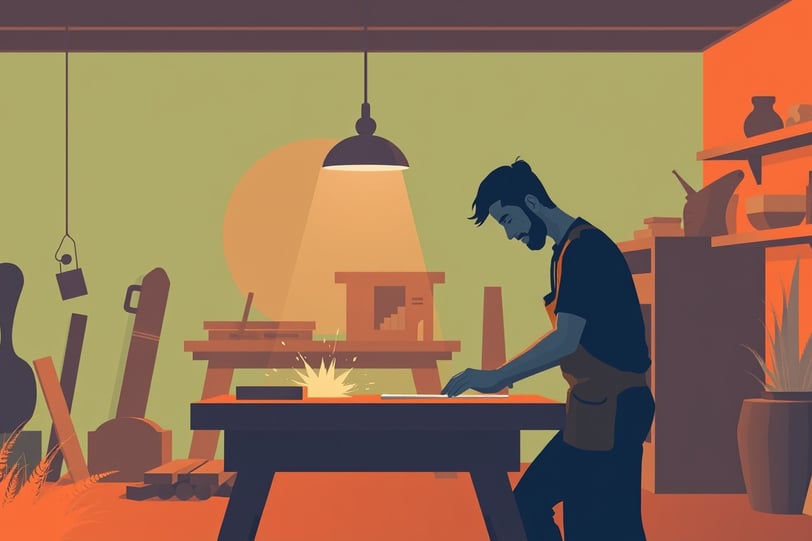Woodworking vs Carpentry – Understanding the Differences and Choosing the Right Path
Woodworking vs carpentry – what’s the difference? Learn how these crafts compare, from tools to techniques, and find out which path is best for your skills and interests.


If you’ve ever looked at a beautifully crafted wooden piece and thought, “I’d love to make something like that,” you’re not alone. I’ve always admired the skill and creativity that go into working with wood. But one thing I’ve noticed is that people often use the terms woodworking and carpentry interchangeably. While they both involve working with wood, they’re actually quite different. So, let’s break it down in a way that makes sense, whether you’re a beginner or just curious about the distinction.
Understanding the Basics: Woodworking vs. Carpentry
At their core, both woodworking and carpentry involve shaping and assembling wood, but the purpose, techniques, and end results set them apart.
Woodworking is typically more about craftsmanship, creativity, and precision. It involves making furniture, decorative items, and intricate designs using tools like chisels, lathes, and hand planes.
Carpentry, on the other hand, leans more towards construction. Carpenters build houses, install framing, and work on structural elements, often using power tools and large-scale materials.
While there’s some overlap, understanding these key differences can help you decide which path suits your interests and goals.


The Art of Woodworking
I believe woodworking is where art meets function. If you’ve ever admired a handcrafted rocking chair or a beautifully carved jewelry box, that’s woodworking in action. This craft requires patience, precision, and often a love for detail.
Common Types of Woodworking:
Cabinet Making – Creating storage units, dressers, and cupboards.
Wood Carving – Turning blocks of wood into intricate sculptures.
Joinery – Constructing wooden joints without nails or screws.
Wood Turning – Using a lathe to shape wood into round objects like bowls.
Woodworkers often use a mix of hand tools and machines to refine their pieces, focusing on aesthetics as much as functionality.


The Practicality of Carpentry
Carpentry, in my opinion, is the backbone of the construction world. It’s about building things that people use daily, like homes, decks, and cabinets. Carpenters work with blueprints, structural integrity, and often collaborate with other trades like electricians and plumbers.
Types of Carpentry:
Rough Carpentry – Framing homes, building structures, and constructing frameworks.
Finish Carpentry – Installing trim, molding, and final woodwork touches.
Formwork Carpentry – Creating molds for concrete structures.
Unlike woodworking, which is often done in a shop, carpentry is mostly performed on-site, requiring different skill sets and tools.


Tools of the Trade: How They Differ
Woodworkers and carpenters use some overlapping tools, but their toolkits look quite different overall.
Woodworkers rely on tools like hand planes, chisels, routers, and scroll saws to shape and refine intricate pieces.
Carpenters use power saws, drills, hammers, and nail guns to assemble large projects efficiently.
If you enjoy working with your hands in a quiet, detail-focused environment, woodworking might be more your style. But if you like working outdoors, tackling big projects, and seeing immediate results, carpentry could be a better fit.
Which one is Right for You?
Choosing between woodworking and carpentry depends on your interests and goals. If you’re passionate about designing, creating, and working on small-scale detailed projects, woodworking offers endless possibilities. But if you prefer hands-on, large-scale work with a direct impact on structures, carpentry is a great career path or hobby.
The best part? You don’t have to pick just one. Many skilled artisans blend both disciplines, crafting custom furniture while also taking on home improvement projects.
Final Thoughts
I’ve always believed that working with wood is one of the most rewarding things you can do. Whether you’re drawn to the creativity of woodworking or the practicality of carpentry, both skills offer a sense of accomplishment that’s hard to beat. If you’re just starting out, try experimenting with small woodworking projects or helping out on a carpentry job site to see what feels right. Either way, the satisfaction of building something with your own hands is something you’ll never regret.
